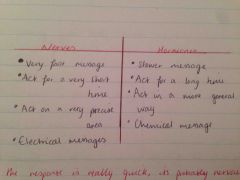![]()
![]()
![]()
Use LEFT and RIGHT arrow keys to navigate between flashcards;
Use UP and DOWN arrow keys to flip the card;
H to show hint;
A reads text to speech;
20 Cards in this Set
- Front
- Back
|
What do sense organs do? |
Contain receptors which detect stimuli |
|
|
What is the pathway of a response to stimuli? |
Receptor - sensory neurone -CNS - motor neurone - effector |
|
|
What is the pathway of a reflex action? How does this differ from a regular response? |
Receptor - sensory neurone - relay neurone - motor neurone - effector
A reflex action bypasses the CNS |
|
|
What is a synapse? |
Used to connect neurones |
|
|
What is the chemical released by a synapse? |
Neurotransmitter |
|
|
What are hormones? |
Chemical messages sent in the blood |
|
|
Which hormones are produced in the pituitary gland? |
LH FSH ADH (controls water content) |
|
|
Which hormones are produced in the pituitary gland? |
LH FSH ADH (controls water content) |
|
|
Where is oestrogen produced? |
Ovaries |
|
|
Which hormones are produced in the pituitary gland? |
LH FSH ADH (controls water content) |
|
|
Where is oestrogen produced? |
Ovaries |
|
|
What does the pancreas produce? |
Insulin for control of blood sugars |
|
|
Differences between nervous responses and hormonal responses |

Back (Definition) |
|
|
Stages of the menstrual cycle |
1 the uterus lining breaks down for 4-7 days
2 the lining of the uterus builds up again from day 7-14, into a thick spongy later full of blood vessels ready to receive a fertilised egg
3 an egg is developed an released from the ovary at day 14
4 the wall is then maintained for about 14 days, until day 28. If no fertilised egg has landed on the uterus wall by day 28, the spongy lining starts to break down and the whole cycle starts again |
|
|
Purpose of FSH |
Causes and egg to develop in one of the ovaries and stimulates the production of oestrogen |
|
|
Purpose of FSH |
Causes and egg to develop in one of the ovaries and stimulates the production of oestrogen |
|
|
Purpose of oestorgen |
Causes the lining of the uterus wall to thicken and grow and stimulates the production of LH/inhibits FSH production |
|
|
Purpose of FSH |
Causes and egg to develop in one of the ovaries and stimulates the production of oestrogen |
|
|
Purpose of oestorgen |
Causes the lining of the uterus wall to thicken and grow and stimulates the production of LH/inhibits FSH production |
|
|
Purpose of LH |
Stimulates the release of an egg |

